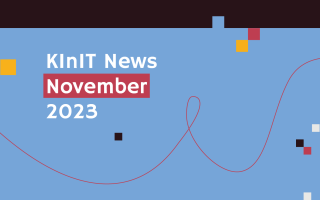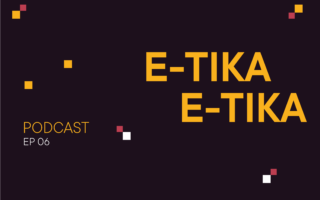What's
Two years with E-tika
In our podcast, we set ourselves the task of exploring the topics of societal and ethical impacts of digital technologies. In the past two seasons, together with our guests, we asked where the limits are when it comes to the development and deployment of new (intelligent) technologies. We have talked about where the red lines are and why crossing them would be wrong.
In this episode, Juraj Podroužek, Miroslav Pikus and Tomáš Gál – hosts of previous E-tika episodes – were given the opportunity to talk about how the E-tika podcast has enriched them, what topics have resonated with them the most, and what has changed in the world of AI ethics in the last two years.
Recently, Europe as well as other parts of the world have seen a strong emphasis on the importance of ethics, particularly in relation to AI regulation. As a result, some authors have started talking about a so-called “ethification”, indicating the proliferation of ethical values in the governance of technology. On the contrary, it has been suggested by other experts (some of us included) that the proposal of the AI Act, which was repeatedly mentioned in our podcast, is not devoting enough of its attention to the concept of ethical and trustworthy AI. Furthermore, UNESCO member states have adopted an agreement upon Recommendation on the ethics of artificial intelligence, after they had discussed it and commented on it with great interest.
However, there has been a visible shift from defining ethical principles that should guide the development of intelligent technologies to their application into practice. Governments, academics and companies no longer devote much effort to generate additional documents where they try to identify these principles, but rather deal with how to realistically apply and fulfill them.
The hosts agreed that various topics were not discussed in the E-tika podcast even though they surely deserve some attention. Among these is the issue of redistribution of benefits brought about by new technologies, as well as the notable impacts of artificial intelligence on the labor market and on the environment. For example, training one complex AI model produces as much CO2 as 60 people or five US cars in their lifetimes. Furthermore, the training period is only the tip of the iceberg, as these systems produce even more CO2 once they are implemented.
Another topic that resonated in the podcast was the issue of new technologies and their impact on democratic processes. Influencing the election campaign takes on a completely different dimension when using AI algorithms, as could be seen in the Cambridge Analytica case. The negative impacts of social networks on users are also present in many other areas, as was revealed by Francis Haugen, former Facebook employee. That raises serious doubts whether the decisions on managing public affairs are still made in public offices, or rather by private companies and online platforms.
There are also calls for less heavy-handed regulation of AI and more self-regulation to help bridge this period of uncertainty or policy vacuum. Reliance on self-regulation might, however, lead to bluewashing or ethics washing. This occurs when the application of the ethical principles in the development and deployment of digital technologies is only superficial.
Moreover, the area of red lines in the use of AI still does not have a fixed scope. The AI Act highlights some red lines, i.e. prohibited practices:
- AI systems using subliminal techniques to exploit our weaknesses or distorting our behavior,
- social scoring by public authorities,
- the use of real-time remote biometric identification systems in public areas for law enforcement purposes.
Perhaps we should also add autonomous weapon systems to the red lines area, together with any other system which, by its nature and design, causes serious negative impacts on human life, health, and generally endangers significant moral values and principles.
Thinking of the current state of AI regulation, the well-known Collingridge’s dilemma seems to apply here. When developing a new technology, we have a lot of control over what it will do, but we can’t yet see the consequences. These are only visible when it is too late to intervene, as the system is already underway. Nevertheless, there are things that can already be incorporated into the design of a new technology, like desired values and principles.
This is where ethics comes into play. Well-designed IT regulation should be built in a hybrid way, where each modality helps steer technology in the desired direction. Simultaneously, it is crucial to strengthen each and every one of them in a different way. We must find the right and unique ways to speak and debate with a lawyer, with a designer or an engineer, and with the public.
How to sum up the ideas of the E-tika podcast in a couple of sentences?
Technology, including AI, is a tool created by humans. It would not exist without us and it is solely up to us how we set up its use. Technology is here for us and not the other way around. And instead of being afraid of new technologies, we should approach them in a way that makes us better. Because technology is here to help us improve ourselves, our environment and society, not only in terms of knowledge but also in terms of human and moral integrity.


